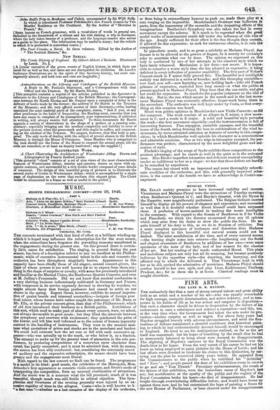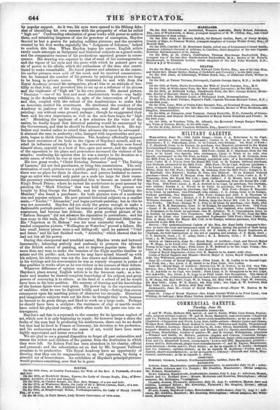FINE ARTS.
THE LATE B. R. HAYDON.
THE melancholy fact that a man of strong natural talents and great ability both as an artist and a teacher of his art—who was equally remarkable for high courage, energetic determination, and active industry, and as tem- perate in his habits of life as he was ardent and sanguine in disposition— that such a character should be driven to desperation by the failure of his endeavours to earn a subsistence and achieve a reputation—and this, too, at the very time when the Government had taken the arts under its pro: tection—excites surprise as well as regret. For above forty years had Haydon struggled bravely with adverse circumstances, and amid the fluc- tuations of fortune maintained a cheerful confidence that historical paint- ing, to which he had enthusiastically devoted himself, would be encouraged in England. He lived to see his anticipations realized, so far as the art itself was concerned; but his hopes of benefiting by the result that he had so strenuously laboured to bring about were doomed to disappointment. The slighting of Haydon's cartoons by the Royal Commission was the death-blow to his hopes. From the very outset of his career he had set his heart on being employed to paint pictures for the House of Lords; and his last efforts were directed to vindicate his claims to this distinction, by car- rying out the plan he conceived thirty years before. He appealed from the Commissioners to the public when he exhibited his " Aristides" and " Nero "; and people passed the door of his exhibition-room in crowds to go and see " Tom Thumb." Pecuniary embarrassments, the result of the failure of this exhibition, were the immediate cause of Haydon's kat act; but mortification at the apathy of the public and the neglect of tits Royal Commission broke his heart—he died of disappointment. He had fought through overwhelming difficulties before; and would have borne up against them now, had he but entertained the hope of painting a fresco for the new Houses of Parliament, or been cheered under his disappointment by popular support. As it was, his eyes were opened to his lifelong delu- sion of identifying his own success with the prosperity of what he called " high art." Confounding admiration of great works with power to achieve them, and mistaking largeness of size for grandeur of conception, Haydon fancied he had a genius for painting sublime pictures; and the sensation created by his first works, especially the " Judgment of Solomon," helped to confirm this idea. When Haydon began his career, English artists rarely made attempts at Scriptural and historical subjects on a grand scale; and the comparative success of his productions appeared greater in conse- quence. His drawing was superior to that of most of his contemporaries; and the vigour of his style and the gusto with which he painted gave an air of power to his efforts, which the enthusiasm of the man also contri- buted to make remarkable. He found patrons and admirers at the outset; his earlier pictures were sold off the easel, and he received commissions: but he lessened the number of his patrons by painting pictures too largo to be hung in private rooms. The treatment he met with from the Royal Academy aroused his antagonism, platel him in an attitude of hos- tility to that body, and provoked him to set up as a reformer of its abuses and the vindicator of "high art " in his own person. His second picture, " Dentatus "—one of his best and most characteristic works—was badly hung in the Academy exhibition, in spite of the intervention of Fuseli • and this, coupled with the refusal of the Academicians to make him i an Associate, excited his resentment. He attributed the conduct of the Academy to jealousy of his rising reputation, and dread of historical painting: not without some ground, perhaps ; though he exaggerated their fears and his own importance, as well as the new-born hopes for " high art." Mistaking the applause of a few admirers for the voice of the nation, he fondly hoped that historical painting would be encouraged by the Government, and that he should be foremost to benefit by it. His tur- biilent zeal tended rather to retard than advance the cause he advocated . it alarmed the men in authority; who, besieged with importunities and pro- jects, began to think them troublesome. The Academy effectually opposed the inert resistence of its body to the vigour of Haydon's assault, and ex- erted its influence privately to stop the movement. Haydon soon found himself alone, opposed to a host of foes, open and secret; and the strength of the opposition to his plans and pretensions increased the violence of his attacks; confirming his opinion that he was a martyr to his devotion to a noble cause, of which he was at once the apostle and champion.
His two great works, " Christ Entering Jerusalem " and " The Raising of Lazarus," did not find purchasers, or bring him commissions. The only destination of such pictures was a public gallery; for, not being altar-pieces, there was no place for them in churches; and patrons hesitated to encou- rage an artist who would only paint on a scale too large for their rooms. His pecuniary embarrassments compelled him to become an inmate of the King's Bench Prison-' where he turned his misfortunes to good account by painting the " Mock Election" that was held there. The picture was bought by King George the ,Fourth; and its companion, "Chairing the Member," also found a purchaser: for both pictures were of a moderate size and popular subjects. He now painted historical subjects on a smaller w ale,—" Eucles," " Alexander," and began portrait-painting; but in this he was not successful. Hayden did not study the graces enough to make a fashionable portrait-painter; and his manner of painting, always tending to coarseness, had become less delicate. His great portrait picture of the "Reform Banquet " did not advance his reputation in portraiture; and his best essay in this walk, the " Anti-Slavery Society," attracted little notice. His "Napoleon at St. Helena" was his most successful work. The in- tended companion picture, " Wellington at Waterloo," proved a failure. His late small history pieces were a sad falling-off; until he painted " Uriel and Satan," and his last finished work, "Aristides," which showed that he had not lost all his power.
During this checquered and troubled career, Haydon wrote and lectured incessantly; labouring actively and zealously to promote the advance of the British school of painting, and to improve popular taste. He did more than any man to make the beauties of the Elgin marbles familiar to artists and the public; and, however he may have mixed himself up with his subject, his advocacy was not the less sincere and disinterested. Both in his writings and his conversation he was as warmly eloquent in praise of fine qualities in works of art as he was violent in his censure of their defects.
Whatever difference of opinion may exist about his merits as a painter, Haydon's place among English artists is in the foremost rank; as a lec- turer and teacher he showed complete knowledge of his subject, and great powers of conveying it to others: at the head of a school of art he would have been in his true position. His mastery of drawing and his knowledge of the human figure were very great. His power lay in the representation of realities: what he saw he depicted boldly and truly—bating that excess consequent upon his marking points of character too strongly. Historical and imaginative subjects were not his forte: he thought they were, because he burned to do great things, and liked to work on a large scale. Perhaps he should have been a sculptor: the resistance of clay or marble would have suited his physical energy, which often made his gusto run into ex- travagance.
Haydon's sad fate is a reproach to the country for its ignorant neglect of art, which now it is only beginning to repair; - for however large a share the faults of the man had in producing his misfortunes, there can be no doubt but that had he lived in France or Germany, his devotion to his profession, and his endeavours to advance the cause of art, would have been more highly appretiated and better rewarded.
We are glad to see a general disposition to forget all past animosities, and rescue the widow and children of the painter from the destitution in Which they were left. Sir Robert Peel has been abundant in his charity, official and personal; and the subscription set on foot by Mr. Sergeant Talfourd promises to be productive. The Royal Academy have an opportunity of showing that they can be magnanimous to an old opponent, by doing a graceful act of benevolence. An exhibition of Haydon's principal pictures would, produce something, now that he is gone.



























 Previous page
Previous page